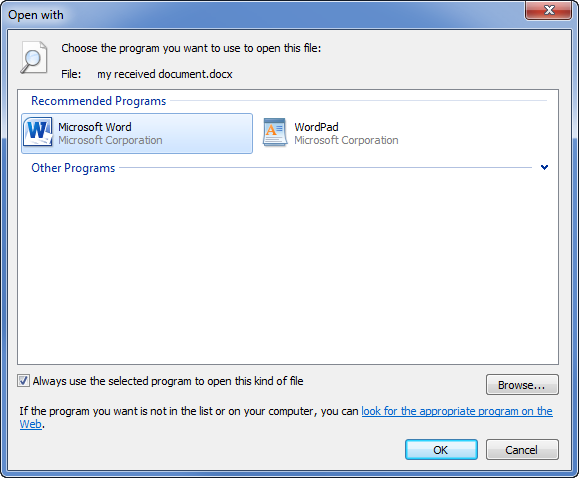

- WINDOWS 10 CHANGE DEFAULT APPLICATION FOR FILE EXTENSION UPDATE
- WINDOWS 10 CHANGE DEFAULT APPLICATION FOR FILE EXTENSION PORTABLE
- WINDOWS 10 CHANGE DEFAULT APPLICATION FOR FILE EXTENSION WINDOWS
#WINDOWS 10 CHANGE DEFAULT PROGRAM FOR EXTENSION FOR WINDOWS 10# The classic Control Panel, for as long as it is still part of Windows, offers a solution.
WINDOWS 10 CHANGE DEFAULT APPLICATION FOR FILE EXTENSION UPDATE
Update: Microsoft changed the Control Panel options in the Windows 10 Fall Creators Update so that they redirect to the Settings application instead. #WINDOWS 10 CHANGE DEFAULT PROGRAM FOR EXTENSION UPDATE# The Settings application, however, lists installed programs or Windows Store apps only. There is no option to set a program not suggested by Windows as the default handler for a specific protocol or file type. You may open the classic management screens in the following way. Note that it is likely that Microsoft will remove these eventually: Tap on the Windows-key, type cmd.exe and select the result to open the Command Prompt.Type control /name Microsoft.DefaultPrograms /page pageDefaultProgram to open the "Set your default programs" Control Panel window.Type control /name Microsoft.DefaultPrograms /page pageFileAssoc to open the "associate a file type or protocol with a program" Control Panel window.

Use Windows-Pause to open the Control Panel. If you don't have a Pause-key, tap on Windows, type Control Panel and hit enter. Select "Control Panel Home", and on the next screen "Default Programs". Select "Associate a file type or protocol with a program" on the screen that opens. This loads all known file types and protocols in a long list. Each extension or protocol is listed with its file extension or protocol, a description, and the current program associated with it. There is no easy way to do this, which means that you have to locate all file extensions or protocols that you want to map to a program manually in the listing. This can take quite some time depending on the program. A media player can be associated with dozens of file types for instance. To change the association of an extension or protocol double-click on its line in the listing. Note: If you get "Windows can't open this type of file", select "try an app on this PC" first. Windows displays a selection menu that resembles the one from the Settings application but lists an option at the very bottom to "look for another app on this PC". This option loads a file browser that you use to select the executable file manually on the system.
WINDOWS 10 CHANGE DEFAULT APPLICATION FOR FILE EXTENSION PORTABLE
It enables you to select portable programs and programs not listed by Windows in the Settings menu. Note: You may need to click on "more apps" in the menu first, then scroll all the way down until you find the option listed in it. Repeat the procedure for all file extensions and protocols you want to map to the program. Tip: You may also want to try the "set your default programs" option of the Control Panel applet. This makes things easier as it allows you to map all supported file extensions and protocols to a program. Windows may not list portable programs in the menu, however. Windows users who don't run portable apps on their system may never encounter the issue, but those who do will run into issues when they try to map it to file extensions or protocols as Microsoft has not added that option to the Settings application. Is it an oversight, metrics that show that portable application use is insignificant, or one way to promote Windows Store apps? We don't know at this point, but it is something that Microsoft should address before it removes the Control Panel for good.Ī lot of the frustration here seems a little crazy to me. #WINDOWS 10 CHANGE DEFAULT PROGRAM FOR EXTENSION PORTABLE# In order to make a program act as the default program for a given file type, you can still do exactly the same thing that has been possible all the way back to Windows 95.

#WINDOWS 10 CHANGE DEFAULT PROGRAM FOR EXTENSION FULL#.#WINDOWS 10 CHANGE DEFAULT PROGRAM FOR EXTENSION UPDATE#.


 0 kommentar(er)
0 kommentar(er)
